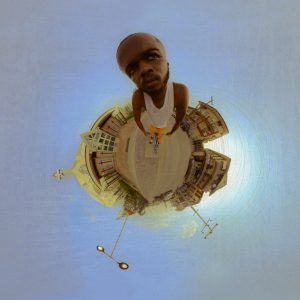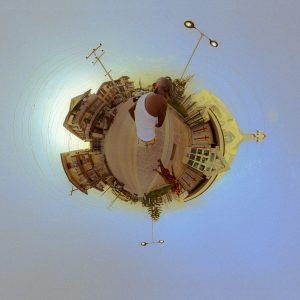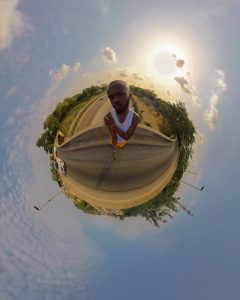NCVRD: How Ruby Okoro Created BOJ’s ‘Gbagada Express’
"I picked prominent places that meant something, that represented Gbagada as much as him."
"I picked prominent places that meant something, that represented Gbagada as much as him."
The fisheye lens comes from a long history of experimental photography. American physicist Robert W. Wood first explored with the form in 1906 by combining real-life elements to replicate the effect of looking at surfaces how a fish would see it. It has since occupied the canon of visual creation around music for decades.
For the album artwork of musician BOJ’s sophomore album, ‘Gbagada Express’, the Lagos-based visual artist Ruby Okoro utilised this same style to represent the weight of Gbagada’s impact on the singer. “I always try to breathe life into [my work and] make it multi-dimensional,” Ruby said to The NATIVE some weeks ago. “As much as I like creating images, I still have to have those colours, have it kind of distorted. I’m very experimental, so for every project I need to try something new. It’s a personal thing; I use every project to accomplish ideas I have in mind”.
View this post on Instagram
Born in the southeastern state of Enugu and later residing in Lagos and Rome, Ruby Okoro is as eclectic as they come. His work combines disparate elements from the art found in these influential cities. He asserts that within every project of his “there has to be something that speaks culture”.
Cultural current flows surely on ‘Crystal Visions Of You’, among Ruby’s most recent work. When I inquire the stuff he’s most excited about as a creator, no time is wasted in choosing this. “It’s an idea that stuck with me,” he explains. “Other ideas kind of grew on me, but this was something that was with me since the start.”
Ruby was even better prepared for the BOJ artwork due to his familiarity with the musician’s catalogue. “BOJ DM’d me [earlier this year], in the normal way artists have been DM’ing me to work,” he says. “It was pretty straight, he told me he wanted a cover and sent me a cartoon reference of Tiny Planets. And like I said, I always have ideas so I’ve been waiting for someone to fully experiment with the Tiny Planets,” he says.
It was fated as Ruby had previously delved into the Tiny Planet aesthetic. From there, the pair began conceiving the inception of what is now the cover to ‘Gbagada Express.’ Ruby shares, “That’s where my vision now comes into light: me talking about how I want the cover to look, the font and all that. Then him looking through the back as the back cover, then the rollout video, him riding through Gbagada.”
The vision was to keep the artwork close to BOJ’s roots. It was Ruby’s decision to feature landmarks within the central Lagos area. “I rode around that day, sourced out locations, places I’ll love to use. There’s an image with him standing on the express as well–that’s the Gbagada Express. I picked prominent places that meant something, that represented Gbagada as much as him. And also that church, too. I think that’s a popular place in Gbagada. So it still boils down to having a touch of me in the work.”

Speaking to Ruby about BOJ, it’s easy to see why the pair created such an iconic cover. The musician’s laidback vibe eased him into the faster paced world of music, and art was the priority. “It’s BOJ now,” he says lightheartedly when I ask how the textures of sound influenced his own creative choices. “I’ve been listening to BOJ’s music for a while. It didn’t feel forced so I knew how to visually represent him,” he says. “It’s something else when it’s a fresh act coming to you to shape how they’re visually represented [against] someone who’s been in the culture and who’s doing what he’s doing. For visual artists, if you know what’s up you can nail it.”
Okoro also wanted to capture the peculiarities of BOJ’s everyman personality. “The styling was very homely. It felt like a boy in the hood thing. He wasn’t rocking jewellery, he wasn’t dripped out. I wanted to show a normal BOJ, just waking up, riding his bicycle to go and buy Agege [bread] or something,” he shares with the NATIVE.
Speaking about the music on the album, Okoro shares that “It’s a blend of everything and I fuck with it,” he says. “I fuck with how he also has the remix that he didn’t release; it’s kind of fresh. ‘In A Loop’ is a jam, that shit is on repeat every single time. ‘Owo Ni Koko’ is a jam too. It’s why I say you can never go wrong with BOJ. He’s like one of those guys that are your favourites’ favourite, but they won’t tell you. They’ll just lock it up and face their front. But if you know you know.”
Ruby tells me that he began creating right from early childhood. He loved sketching and drawing and would later on dabble in music production. He won some writing competitions in high school. Photography came much later. “That felt like the best way to express everything,” he says. His sights set on going professional by 2017, he began creating images which held one spellbound, coloured by community and mystery in ways peculiar to Ruby. VSCO began paying him not long after. “Just for being hard,” he chips in with a laugh. He knew then he had something special.
He grew into his creativity and with that, more clients came calling. His ascent within Nigerian art circles coincided with the primal stages of the alté counterculture. Lady Donli was an early collaborator, modelling for Ruby’s hybrid project, ‘Wetin You Sabi?’. The brilliance of contemporary visual artists unarguably contributes to the growing relevance of creative direction across entertainment, especially for musicians like BOJ.
As Afropop launches further into deep pockets of global pop culture, more musicians are in need of cohesive presentation. Ruby’s trademark flourishes have created compelling portraits of Teezee, Oxlade and Mavin Records signee Magixx.


Featured image credits/NATIVE

